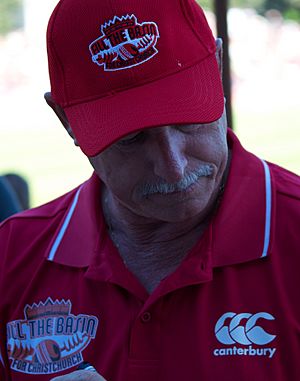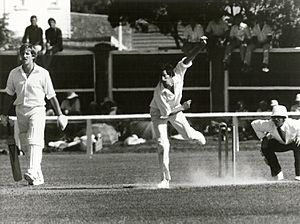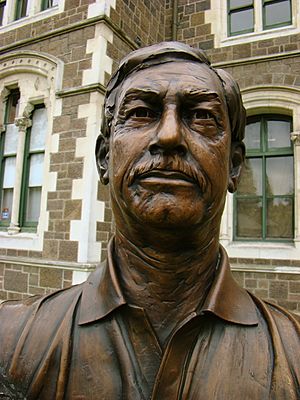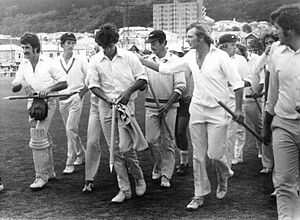Richard Hadlee facts for kids

Hadlee in March 2011
|
||||||||||||||||||||||||||||||||||||||||||||||||||||||||||||||||||
| Personal information | ||||||||||||||||||||||||||||||||||||||||||||||||||||||||||||||||||
|---|---|---|---|---|---|---|---|---|---|---|---|---|---|---|---|---|---|---|---|---|---|---|---|---|---|---|---|---|---|---|---|---|---|---|---|---|---|---|---|---|---|---|---|---|---|---|---|---|---|---|---|---|---|---|---|---|---|---|---|---|---|---|---|---|---|---|
| Full name |
Richard John Hadlee
|
|||||||||||||||||||||||||||||||||||||||||||||||||||||||||||||||||
| Born | 3 July 1951 St Albans, New Zealand |
|||||||||||||||||||||||||||||||||||||||||||||||||||||||||||||||||
| Nickname | Paddles, Sir Paddles | |||||||||||||||||||||||||||||||||||||||||||||||||||||||||||||||||
| Height | 6 ft 1 in (1.85 m) | |||||||||||||||||||||||||||||||||||||||||||||||||||||||||||||||||
| Batting | Left-handed | |||||||||||||||||||||||||||||||||||||||||||||||||||||||||||||||||
| Bowling | Right-arm fast | |||||||||||||||||||||||||||||||||||||||||||||||||||||||||||||||||
| Role | Bowling All-rounder | |||||||||||||||||||||||||||||||||||||||||||||||||||||||||||||||||
| Relations | Walter Hadlee (father) Barry Hadlee (brother) Dayle Hadlee (brother) |
|||||||||||||||||||||||||||||||||||||||||||||||||||||||||||||||||
| International information | ||||||||||||||||||||||||||||||||||||||||||||||||||||||||||||||||||
| National side |
|
|||||||||||||||||||||||||||||||||||||||||||||||||||||||||||||||||
| Test debut (cap 123) | 2 February 1973 v Pakistan | |||||||||||||||||||||||||||||||||||||||||||||||||||||||||||||||||
| Last Test | 5 July 1990 v England | |||||||||||||||||||||||||||||||||||||||||||||||||||||||||||||||||
| ODI debut (cap 6) | 11 February 1973 v Pakistan | |||||||||||||||||||||||||||||||||||||||||||||||||||||||||||||||||
| Last ODI | 25 May 1990 v England | |||||||||||||||||||||||||||||||||||||||||||||||||||||||||||||||||
| Domestic team information | ||||||||||||||||||||||||||||||||||||||||||||||||||||||||||||||||||
| Years | Team | |||||||||||||||||||||||||||||||||||||||||||||||||||||||||||||||||
| 1971/72–1988/89 | Canterbury | |||||||||||||||||||||||||||||||||||||||||||||||||||||||||||||||||
| 1978–1987 | Nottinghamshire | |||||||||||||||||||||||||||||||||||||||||||||||||||||||||||||||||
| 1979/80 | Tasmania | |||||||||||||||||||||||||||||||||||||||||||||||||||||||||||||||||
| Career statistics | ||||||||||||||||||||||||||||||||||||||||||||||||||||||||||||||||||
|
||||||||||||||||||||||||||||||||||||||||||||||||||||||||||||||||||
|
Source: CricInfo, 1 September 2007
|
||||||||||||||||||||||||||||||||||||||||||||||||||||||||||||||||||
Sir Richard John Hadlee (born 3 July 1951) is a famous former cricketer from New Zealand. Many people think he is one of the greatest all-rounders in cricket history. He is also considered one of the best fast bowlers ever.
Richard Hadlee was made an MBE in 1980. He was later made a knight in 1990 for his amazing contributions to cricket. He used to be the chairman of the New Zealand cricket team selectors. In 2002, Wisden, a famous cricket publication, named him the second greatest Test bowler of all time.
In 2009, a bronze statue of Hadlee was put up outside the Christchurch Arts Centre. This was to honor him as one of the "Twelve Local Heroes." On April 3, 2009, Hadlee was added to the ICC Cricket Hall of Fame. He comes from a well-known cricket family, with his father and brothers also playing the sport.
Contents
About Richard Hadlee's Life
Richard Hadlee was born on July 3, 1951, in St Albans, Christchurch. His father, Walter Hadlee, and two of his brothers, Dayle and Barry, played cricket for New Zealand. His former wife, Karen, also played international cricket for New Zealand.
After he retired, Hadlee found out he had a heart condition called Wolff–Parkinson–White syndrome. He had surgery for it in July 1991. He had this condition since birth and sometimes felt an irregular heartbeat during his career. Today, Hadlee stays active and works with the Heart Foundation. In June 2018, he was diagnosed with bowel cancer and had surgery to remove a tumor.
Richard Hadlee's Test Cricket Career
Richard Hadlee was a bowling all-rounder. This means he was good at both bowling and batting. In his 86 Test matches, he took 431 wickets. At the time, this was a world record, and he was the first bowler to reach 400 wickets. His bowling average was 22.29. He also scored 3,124 runs in Tests, with an average of 27.16. This included two centuries (scores of 100 or more) and 15 half-centuries (scores of 50 or more).
Many experts believe Hadlee was the best at bowling with a new ball. He was known for his amazing swing bowling. He was called the "Sultan of Swing." Hadlee was one of the top fast bowlers of his time. This was even though other great bowlers like Dennis Lillee and Imran Khan were also playing.
Hadlee was one of four top all-rounders of his era, along with Imran Khan, Kapil Dev, and Ian Botham. He had the best bowling average among them.
Early Career and Breakthrough Wins
Hadlee started playing first-class cricket for Canterbury in 1971/72. He made his Test match debut in 1973. In both his first games, his very first ball was hit for a boundary. For a few years, Hadlee's performance in Tests was not always consistent. However, he had a big breakthrough against India in 1976. He took 11 wickets in that game, helping New Zealand win. This secured his place in the team.
In 1978, Hadlee helped New Zealand achieve a historic first win against England. He took 6 wickets for only 26 runs in England's second innings. This helped bowl England out for just 64 runs, as they chased a target of 137.
Record-Breaking Performances
In 1979/80, New Zealand played the West Indies at home. The West Indies were a very strong team back then. In the first Test in Dunedin, New Zealand won by just 1 wicket, which was a big surprise. Hadlee took 11 wickets in that game. In the second Test, Hadlee scored his first Test century. This helped New Zealand draw the match and win the series 1–0. This win started a 12-year period where New Zealand did not lose a home Test series.
In 1983, New Zealand toured England. They got their first-ever Test win on English soil at Headingley. Hadlee took his 200th Test wicket in the final Test at Nottingham. In 1984, New Zealand beat England in Christchurch. Hadlee had a great all-round performance, taking 8 wickets and scoring a quick 99 runs. These efforts helped him become the number one Test bowler in the world in 1984. He held this top spot for the next four years.

From 1985/86, Hadlee became an even greater fast bowler. On New Zealand's tour to Australia, he had an amazing all-round performance in the first Test at Brisbane. He took his personal best of 9 wickets for 52 runs in Australia's first innings. He also scored 54 runs and took 6 more wickets in Australia's second innings. This helped New Zealand win by an innings. Hadlee took 33 wickets in just 3 Tests during that series. This gave New Zealand their first series win in Australia. In the next series in New Zealand, Hadlee took his 300th Test wicket.
In 1986, Hadlee helped New Zealand win a series in England, their first ever there. His outstanding performance in the second Test at Nottingham was key. He took 10 wickets and scored 68 runs, leading his team to victory.
Later Career and Retirement
In April 1987, New Zealand went to Sri Lanka. Hadlee scored his second Test century, 151 not out, which helped New Zealand save the first game. However, the tour ended early because a bomb exploded near the team's hotel in Colombo.
Hadlee's desire to compete against Australia showed again in 1987/88. In the third Test in Australia, he took 10 wickets. He almost led New Zealand to a series-tying victory. The match ended with Australia's last batsman surviving Hadlee's final over. If Hadlee had taken one more wicket, New Zealand would have won. He also would have broken Ian Botham's world record for Test wickets.
In the next home series against England, everyone was excited for Hadlee to break the world record. However, Hadlee got injured on the first day and missed the rest of the series. Many thought he might not play cricket again.
But Hadlee recovered and got his chance to break the Test wicket world record in India in 1988. He took his 374th Test wicket in the first Test of the series, setting a new record. In the second Test, he took 10 wickets, helping New Zealand win a rare Test match in India.
In a home series against India in 1989/90, Hadlee made history again. He became the first bowler to take 400 Test wickets. This happened when he dismissed Sanjay Manjrekar in the first Test in Christchurch, his home ground. Soon after, Hadlee announced he would retire after the upcoming tour to England.
Before his last Test series in England, Hadlee was made a Knight Bachelor for his services to cricket. He became Sir Richard Hadlee. He celebrated this by scoring 86 runs and winning the man of the match award in the second Test. In his final Test match, Hadlee ended his career by taking 5 wickets in his last bowling performance. He even took a wicket with the very last ball of his Test career.
Playing for Nottinghamshire
Richard Hadlee played for Nottinghamshire in England between 1978 and 1987. He had some amazing bowling performances there. For example, he took eight wickets for only 22 runs against Surrey in 1984.
He played three full seasons for Nottinghamshire. His bowling numbers in those seasons were incredible:
- 1981: 105 wickets for an average of 14.89 runs each.
- 1984: 117 wickets for an average of 14.05 runs each.
- 1987: 97 wickets for an average of 11.89 runs each.
In these three seasons, his fellow players voted him the PCA Player of the Year.
In 1984, Hadlee achieved a rare feat called the county 'double'. This means he scored 1,000 runs and took 100 wickets in the same season. He was one of only two players to do this in English county cricket since 1969. His highest first-class score, 210 not out, was part of this achievement. In 1987, his last season, he almost achieved the double again as Nottinghamshire won the County Championship.
Playing for Canterbury
Because of different seasons, Hadlee also played provincial cricket in New Zealand for Canterbury.
The north stand of the AMI Stadium was named the Hadlee stand. This honored Richard Hadlee and his family's contributions to cricket. The Chappell–Hadlee Trophy, a competition between New Zealand and Australia in one-day matches, is named after the Hadlee family and Australia's Chappell family.
Hadlee was also a good association football player. He played for the Rangers A.F.C. team in Christchurch.
Hadlee's Bowling Style

Hadlee was a right-arm fast bowler. When he was young, he was extremely fast. As he got older, he shortened his run-up. This helped him become more accurate and get the ball to move a lot in the air and off the pitch. His most effective delivery was the outswinger, which became his main weapon later in his career.
Dennis Lillee, another famous fast bowler, was a big influence on Hadlee. Hadlee saw Lillee as the perfect example of a fast bowler. He admired Lillee's strength, fitness, confidence, and skill. Lillee believed that determination was key to his own success. He thought Hadlee was incredibly skillful, especially with his consistent outswingers.
Hadlee's bowling action was very efficient. He often bowled very close to the stumps, sometimes even knocking the bails off. This helped him trap many batsmen leg before wicket. He broke the Test wicket-taking record on November 12, 1988, in India. He took his 400th Test wicket on February 4, 1990. In his final Test match, on July 9, 1990, he dismissed Devon Malcolm with the very last ball of his Test career.
Hadlee's Batting Style
Hadlee was an aggressive left-handed batsman who usually batted in the middle of the order. While his batting wasn't as strong against the very best international bowlers, he was very good at scoring runs against less experienced attacks. He ended his career with 15 Test half-centuries and two Test centuries. For Nottinghamshire in 1984, 1986, and 1987, he averaged over 50 runs. This is a rare achievement for a bowler.
The Sir Richard Hadlee Sports Trust

In August 1990, Hadlee started The Sir Richard Hadlee Sports Trust. This trust helps young athletes and artists who are facing difficulties. It supports them in reaching their goals in sports or cultural activities. To get help, applicants must be under 25 years old and from the Canterbury region of New Zealand. They must also be facing hardship or special circumstances that stop them from pursuing their dreams. The Trust relies on donations from the community and sponsors.
International Records and Awards
- Hadlee was the first player to score 1,000 runs and take 100 wickets in One Day International (ODI) cricket.
- He was the second fastest bowler to take five-wicket hauls in 25 Test matches. He was the fastest fast bowler to do this, reaching it in 62 matches.
- He took a total of 36 five-wicket hauls in Test matches and five in ODIs. His Test record was the highest at the time he retired.
- He had the best single innings bowling figures by any fast bowler in the 20th century. He took 9 wickets for 52 runs against Australia in 1985.
Sporting Awards
Hadlee received many awards during his career, including:
- Appointed MBE for services to New Zealand sport in 1980.
- Awarded a Knighthood for services to cricket in 1990.
- Winner of the Windsor Cup 13 times, including 12 years in a row, for the best bowling performance of the season.
- New Zealand Sportsman of the Year in 1980 and 1986.
- Wisden Cricketer of the Year in 1982.
- New Zealand Sportsperson of the last 25 years in 1987 (shared with runner John Walker).
- New Zealand Sportsperson of the Decade in 1987.
- Bert Sutcliffe Medal in 2008.
- Inducted into the ICC Cricket Hall of Fame in 2009.
- Inducted into the NZC Hall of Fame in 2024 as one of the First XI.


